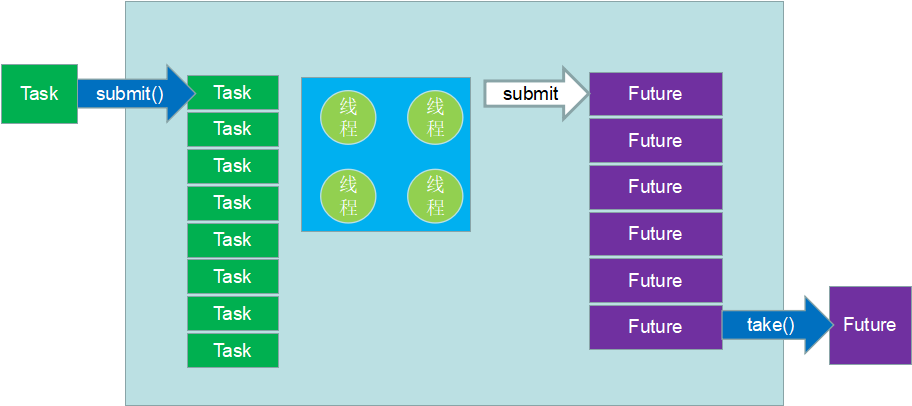Java8的CompletionService使用与原理
为了防止无良网站的爬虫抓取文章,特此标识,转载请注明文章出处。LaplaceDemon/ShiJiaqi。
https://www.cnblogs.com/shijiaqi1066/p/10454237.html
CompletionService是Java8的新增接口,JDK为其提供了一个实现类ExecutorCompletionService。这个类是为线程池中Task的执行结果服务的,即为Executor中Task返回Future而服务的。CompletionService的实现目标是任务先完成可优先获取到,即结果按照完成先后顺序排序。
CompletionService的使用非常简单。从源码查看ExecutorCompletionService类,该类只有三个成员变量:
public class ExecutorCompletionService<V> implements CompletionService<V> {
private final Executor executor;
private final AbstractExecutorService aes;
private final BlockingQueue<Future<V>> completionQueue;
...
}
可以看到ExecutorCompletionService主要是增强executor线程池的。Task包装后被塞入completionQueue,当Task结束,其Future就可以从completionQueue中获取到。
其基本原理可以参看下图:

CompletionService接口源码:
public interface CompletionService<V> {
// 提交
Future<V> submit(Callable<V> task);
Future<V> submit(Runnable task, V result);
// 获取
Future<V> take() throws InterruptedException;
Future<V> poll();
Future<V> poll(long timeout, TimeUnit unit) throws InterruptedException;
}
例:向CompletionService中提交10个Task,当Task有任务返回则会优先从CompletionService内部的队列中获取到Task的Future。
package test;
import java.util.ArrayList;
import java.util.Date;
import java.util.List;
import java.util.concurrent.Callable;
import java.util.concurrent.CompletionService;
import java.util.concurrent.ExecutorCompletionService;
import java.util.concurrent.ExecutorService;
import java.util.concurrent.Executors;
import java.util.concurrent.Future;
public class TestCompletionService {
public static void main(String[] args) {
Long start = System.currentTimeMillis();
//开启3个线程
ExecutorService exs = Executors.newFixedThreadPool(5);
try {
int taskCount = 10;
// 结果集
List<Integer> list = new ArrayList<Integer>();
List<Future<Integer>> futureList = new ArrayList<Future<Integer>>();
// 1.定义CompletionService
CompletionService<Integer> completionService = new ExecutorCompletionService<Integer>(exs);
// 2.添加任务
for(int i=0;i<taskCount;i++){
Future<Integer> future = completionService.submit(new Task(i+1));
futureList.add(future);
}
// 3.获取结果
for(int i=0;i<taskCount;i++){
Integer result = completionService.take().get();
System.out.println("任务i=="+result+"完成!"+new Date());
list.add(result);
}
System.out.println("list="+list);
} catch (Exception e) {
e.printStackTrace();
} finally {
//关闭线程池
exs.shutdown();
}
}
static class Task implements Callable<Integer>{
Integer i;
public Task(Integer i) {
super();
this.i=i;
}
@Override
public Integer call() throws Exception {
if(i==5) {
Thread.sleep(5000);
}else{
Thread.sleep(1000);
}
System.out.println("线程:"+Thread.currentThread().getName()+"任务i="+i+",执行完成!");
return i;
}
}
}


